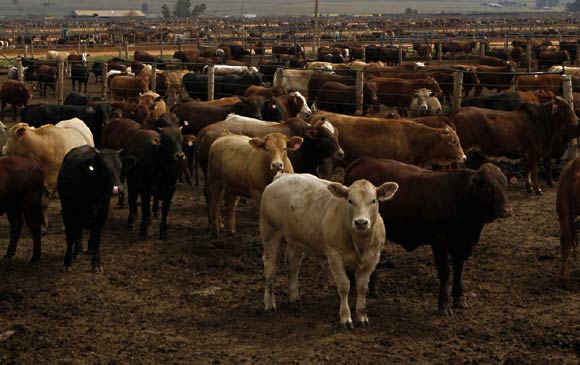47% of samples tested had the type of bacteria that most commonly causes staph infections. Food animals routinely fed antibiotics are a possible source.

The use of antibiotics should be curtailed in the agriculture industry, the author of a new study on staph in the food supply says. (Siphiwe Sibeko / Reuters)
Meat in the U.S. may be widely contaminated with strains of drug-resistant bacteria, researchers reported Friday after testing 136 samples of beef, chicken, pork and turkey purchased at grocery stores.
Nearly half of the samples — 47% — contained strains of Staphylococcus aureus, the type of bacteria that most commonly causes staph infections. Of those bacteria, 52% were resistant to at least three classes of antibiotics, according to a study published in the journal Clinical Infectious Diseases.
DNA testing suggested the animals were the source of contamination. Environmental health scientist Lance Price, the study’s leader, said the animals most likely harbored these drug-resistant pathogens because antibiotics routinely are fed to livestock to promote growth and prevent disease in crowded pens on large farms.
“These findings really point to serious problems with the way food animals are raised in the U.S. today,” said Price, who directs the Center for Food Microbiology and Environmental Health at the Translational Genomics Research Institute, a nonprofit biomedical research center in Phoenix.
Last summer, the Food and Drug Administration urged the meat industry to cut back on antibiotic use out of concern that the practice breeds drug-resistant bacteria in stockyards and makes antibiotics less effective in humans.
But other scientists said it was premature to conclude that antibiotics in animal feed were to blame. About half of all humans have staph bacteria in their noses or throats, and a food handler with poor hygiene could introduce the pathogen to the food supply, said Beilei Ge, a food scientist at Louisiana State University in Baton Rouge.
The meat and poultry samples tested in the study represented 80 brands and were purchased in Los Angeles, Chicago, Fort Lauderdale, Fla., Flagstaff, Ariz., and Washington, D.C.
Scientists incubated the samples for up to 24 hours in a broth that was kept at human body temperature and used genetic tests to determine whether they contained the staph bacteria. Then they treated them with vancomycin, oxacillin, tetracycline and other antibiotics to determine whether they were resistant to the drugs.
The research was funded by the Pew Campaign on Human Health and Industrial Farming, which opposes the routine use of antibiotics in animal feed.
About 11,000 people die every year from S. aureus infections, according to the Centers for Disease Control and Prevention, and more than half of those deaths are from the hospital “superbug” methicillin-resistant S. aureus, or MRSA.
The direct risk that consumers may acquire a staph infection from meat can be reduced by cooking meat thoroughly and washing all foods and surfaces that come into contact with raw meat, whether or not it is resistant to antibiotics.
However, Caroline DeWaal, director of food safety at the Center for Science in the Public Interest in Washington, D.C., said the study results suggest that consumers might benefit by wearing gloves when they handle raw meat. “It’s making us rethink our advice to the public,” she said.
The American Meat Institute, which represents producers, said Friday that the country’s meat and poultry supply was safe. And data from the CDC show that cases of food-borne illness in the U.S. have declined 20% in the last decade.
William Marler, a leading food safety attorney, said it was helpful to test meat samples available in stores because the U.S. Department of Agriculture’s Food Safety and Inspection Service focused its testing on meat production facilities.
“It’s good to see more people doing retail testing because it shows us that our meat is far less sanitary than most consumers would think,” he said.
But the bigger threat to public health is that widespread antibiotic use in livestock could make the drugs increasingly ineffective in humans, Price said.
The American Medical Assn., the World Health Organization and other medical groups have warned that the misuse of antibiotics in food animal production may be creating a serious problem for human health by fostering development of drug-resistant bacteria.
Studies in Canada and Denmark show that taking antibiotics out of animal feed makes antibiotic-resistant bacteria less prevalent in both animals and people with no ill effects for animals or ranchers, Price said.
“Our lifesaving medications are being used as tools to make animals grow faster,” Price said. “We must do everything we can to protect these antibiotics that protect our health.”
By Marissa Cevallos and P.J. Huffstutter, Special to the Los Angeles Times
April 15, 2011, 4:32 p.m.
Source: The Los Angeles Times